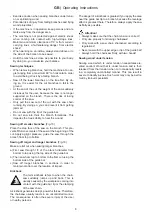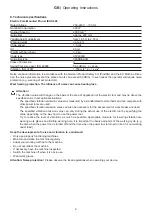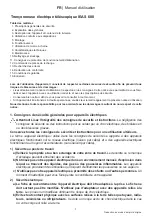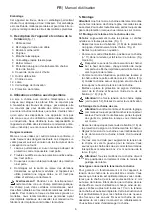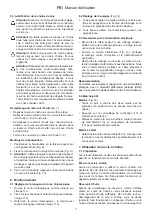
GB
| Operating Instructions
8
• Exercise caution when sawing branches under tensi-
on or splintering wood.
•
Potential risk of injury from falling branches and flying
wood projectiles!
• If the machine is in operation, keep persons and ani-
mals away from the danger area.
• The machine is not protected against electric shock
when coming into contact with high-voltage lines.
Maintain a minimum clearance of 10 m from current-
carrying lines. Life-threatening danger from electric
shock!
• When working on an incline, always stand above or to
the side of the branch to be sawed.
•
Hold the machine as close as possible to your body.
By doing so, you maximise your balance.
Sawing techniques
• When removing branches, hold the machine at an an-
gle ranging from a maximum 60° to horizontal in order
to avoid being struck by a falling branch.
•
Saw off the lower branches on the tree first. By do
-
ing so, it is easier for the cut branches to fall to the
ground.
• At the end of the cut, the weight of the saw suddenly
increases for the user, because the saw is no longer
supported on the branch. There is the risk of losing
control of the saw.
• Only pull the saw out of the cut with the saw chain
running. By doing so, you can prevent it from getting
jammed.
• Do not saw with the tip of the guide bar.
• Do not saw into thick the branch formations. This
impedes the tree‘s ability to heal the wound.
Sawing off smaller branches
(Fig.15)
Place the stop face of the saw on the branch. This pre-
vents fitful movements of the saw at the beginning of the
cut. Applying light pressure, guide the saw through the
branch from top to bottom.
Sawing off larger and longer branches
(Fig.16)
Make a relief cut when sawing larger branches.
a) First saw through 1/3 of the branch diameter from
bottom to top using the top side of the guide bar.
b)
Then saw from top to bottom to the first cut using the
bottom side of the guide bar.
c) Saw off longer branches in sections in order to
maintain control over the location of impact.
Kickback
The term kickback refers to when the chain-
saw suddenly jumps up and back. This is
usually caused by the workpiece coming into
contact with the guide bar tip or the clamping
of the saw chain.
A kickback generates abrupt, powerful forces. Therefore,
the chainsaw usually reacts in an uncontrolled manner.
The consequence is often the severe injury of the user
or nearby persons.
The danger of a kickback is greatest if you apply the area
near the guide bar tip to a branch, because the leverage
effect is greatest there. Therefore, always apply the saw
as flatly as possible.
Attention!
• Always make sure that the chain tension is correct!
• Only use properly functioning chainsaws!
• Only work with a saw chain sharpened according to
regulations!
• Never saw with the upper edge or tip of the guide bar!
•
Always hold the chainsaw firmly with two hands!
Sawing wood under tension
Sawing wood which is under tension necessitates ele-
vated caution! Wood that is under tension and is then
released from that tension when cut occasionally reacts
in a completely uncontrolled manner. This can result in
severe to deadly injuries. Such work may only be perfor
-
med by trained specialists.
Содержание IEAS 600
Страница 2: ......
Страница 3: ...1 2 11 12 A 3 2 3 1 4 6 5 8 7 9 14 13 10 12 11 1 4 5 _ ...
Страница 4: ...2 6 2 mm 7 9 8 9 10 11a 11b ...
Страница 5: ...3 12 13 14 13 3 15 16 ...
Страница 79: ......















